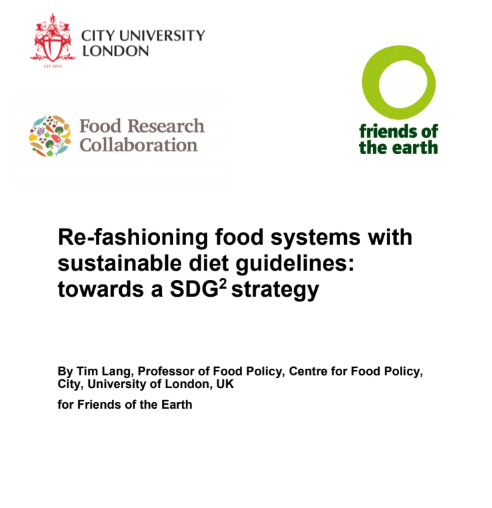In this joint paper with Friends of the Earth’s Big Ideas project, Tim Lang charts the policy progress of sustainable dietary guidelines, setting out a compelling case for their adoption to tackle health inequalities and environmental and social harm caused by current eating patterns. He shows that while official progress is slow, a host of new actors and activists – from cities and local authorities to academics and progressive businesses – are emerging to take the lead in making sustainable diets a reality from the bottom up. You can read his blog about the paper on Friends of the Earth’s Big Ideas project website here.
Download the paper ‘Re-fashioning food systems with sustainable diet guidelines: towards a SDG2 strategy’
Order the new book by Pamela Mason and Tim Lang: Sustainable Diets: How Ecological Nutrition Can Transform Consumption and the Food System.



2 Comments
I haven’t had much time to read this thoroughly, but just wonder where landscape and biodiversity are in all this? Favourite landscapes tend to be meat producing, and agri-environment schemes usually promote extensive grazing (sheep and cattle); the UK grows grass exceptionally well, so meat produced that way has a different environmental impact from grain fed meat which seems to be the basis of some statistics. We have a dwindling heritage of meadows, moors and grazing marsh, if we want to keep them surely we need to eat the produce or accept the consequences! What would the consequences be in terms of landscape and biodiversity – I don’t know! I hope the Wildlife trusts, National Trust, RSPB, Plantlife, Butterfly conservation etc., will have a chance to comment.
Thanks for this. You are absolutely right to raise biodversity and landscape. These have barely featured in the sustainable diet debate so far but are creeping up. I have tried to address landscape / biodiversity much more fully in the book: Mason and Lang Sustainable Diets, Abingdon: Routledge Earthscan which is published on Friday. The FoE blog also makes it clear that landscape regeneration is essential and can follow from using less land to produce grains for animals. I was a sheep farmer in N Lancashire (Forest of Bowland) and learned rapidly that the economics are a bit bonkers. It paid to buy in feed and to lamb earlier (when grass is non-existent), and to get the lamb off the farm sooner than they ought, by climate and available on-farm food. This thus turned sheep down the road that poultry and pigs are well down; beef too. You might not agree with me, but I think we must get real about landscape. As Hoskins pointed out decades ago, there is barely any ‘natural’ landscape in the UK. Humans (and animals) have deforested, drained, built and recalibrated almost all of it. Dartmoor is a rare exception. That fell or moor (like the ones I gathered sheep on) are not natural. They really could and should be more wooded. One doesn’t even need to go the whole ‘rewilding’ route to know that landscape everywhere could be de-stressed more by better diets based on less meat and dairy. The same logic applies to the seas, by the way. TIM LANG